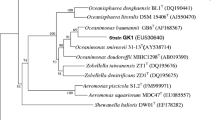Abstract
A new isolated bacterial strain A-04 capable of producing high content of polyhydroxyalkanoates (PHAs) was morphologically and taxonomically identified based on biochemical tests and 16S rRNA gene analysis. The isolate is a member of the genus Ralstonia and close to Ralstonia eutropha. Hence, this study has led to the finding of a new and unexplored R. eutropha strain A-04 capable of producing PHAs with reasonable yield. The kinetic study of poly(3-hydroxybutyrate-co-4-hydroxybutyrate) [P(3HB-co-4HB)] production by the R. eutropha strain A-04 was examined using butyric acid and γ–hydroxybutyric acid as carbon sources. Effects of substrate ratio and mole ratio of carbon to nitrogen (C/N) on kinetic parameters were investigated in shake flask fed-batch cultivation. When C/N was 200, that is, nitrogen deficient condition, the specific production rate of 3-hydroxybutyrate (3HB) showed the highest value, whereas when C/N was in the range between 4 and 20, the maximum specific production rate of 4-hydroxybutyrate (4HB) was obtained. Thus, the synthesis of 3HB was growth-limited production under nitrogen-deficient condition, whereas the synthesis of 4HB was growth-associated production under nitrogen-sufficient condition. The mole fraction of 4HB units increased proportionally as the ratio of γ–hydroxybutyric acid in the feed medium increased at any value of C/N ratio. Based on these kinetic studies, a simple strategy to improve P(3HB-co-4HB) production in shake flask fed-batch cultivation was investigated using C/N and substrate feeding ratio as manipulating variable, and was successfully proved by the experiments.








Similar content being viewed by others
References
Braunegg G, Sonnleitner G, Lafferty RM (1978) A rapid gas chromatographic method for the determination of poly-3-hydroxubutyric acid in microbial biomass. Eur J Appl Microbiol Biotechnol 6:29–37
Braunegg G, Lefebvre G, Genser KF (1998) Polyhydroxyalkanoates, biopolyesters from renewable resources: physiological and engineering aspects. J Biotechnol 65:127–161
Chanprateep S, Abe N, Shimizu H, Yamane T, Shioya S (2001) Multivariable control of alcohol concentrations in the production of polyhydroxyalkanoates (PHAs) by Paracoccus denitrificans. Biotechnol Bioeng 74:116–124
Chen GQ, Wu Q (2005) The application of polyhydroxyalkanoates as tissue engineering materials. Biomaterials 26:6565–6578
Dahlke B, Larbig H, Scherzer H, Poltrock R (1998) Natural fiber reinforced foams based on renewable resources for automotive interior applications. J Cell Plast 34:361–379
Doi Y, Kunioka M, Nakamura Y, Soga K (1988) Nuclear magnetic resonance studies on unusal bacterial copolymers of 3-hydroxybutyrate and 4-hydroxybutyrate. Macromolecules 21:2722–2727
Felsenstein J (1985) Confidence limits on phylogenies: an approach using the bootstrap. Evolution 39:783–791
Grabow N, Schmohl K, Khosravi A, Philipp M, Scharfschwerdt M, Graf B, Stamm C, Haubold A, Schmitz KP, Steinhoff G (2004) Mechanical and structural properties of a novel hybrid heart valve scaffold for tissue engineering. Artif Organs 28:971–979
Kim JS, Lee BH, Kim BS (2005) Production of poly(3-hydroxybutyrate-co-4-hydroxybutyrate) by Ralstonia eutropha. Biochem Eng J 23:169–174
Kimura H, Ohura T, Takeishi M, Nakamura S, Doi Y (1999) Effective microbial production of poly(4-hydroxybutyrate) homopolymer by Ralstonia eutropha H16. Polym Int 48:1073–1079
Kimura M (1980) A simple method for estimating evolutionary rates of base substitution through comparative studies of nucleotide sequences. J Mol Evol 16:111–120
Kunioka M, Kawaguchi Y, Doi Y (1989) Production of biodegradable copolyesters of 3-hydroxybutyrate and 4-hydroxybutyrate by Alcaligenes eutrophus. Appl Microbiol Biotechnol 30:569–573
Malchesky PS (2005) Artificial organs 2004: a year in review. Artif Organs 29(3):268–284
Martin DP, Williams SF (2003) Medical applications of poly-4-hydroxybutyrate: a strong flexible absorbable biomaterial. Biochem Eng J 16:97–105
Murray RGE, Doetsch RN, Robinow CF (1994) Determinative and cytological light microscopy. In: Gerhardt P, Murray RGE, Wood WA, Krieg NR (eds) Methods for general and molecular bacteriology. American Society for Microbiology, Washington, pp 22–41
Park SJ, Choi J, Lee SY (2005) Engineering of Escherichia coli fatty acid metabolism for the production of polyhydroxyalkanoates. Enzyme Microb Technol 36:579–588
Shimizu H, Takiguchi N, Tanaka H, Shioya S (1999) A maximum production strategy of lysine based on a simplified model derived from metabolic reaction network. Metab Eng 1(4):299–308
Senior PJ, Dawes EA (1973) The regulation of poly-β-hydroxybutyrate metabolism in Azotobacter beijerkinki. Biochem J 134:225–238
Shioya S (1992) Optimization and control in fed-batch bioreactors. In: Fichter A (ed) Adv Biochem Eng Biotechnol. Springer, Berlin, pp 111–142
Smibert RM, Krieg NR (1994) Phenotypic characterization. In: Gerhardt P, Murray RGE, Wood WA, Krieg NR (eds) Methods for general and molecular bacteriology. American Society for Microbiology, Washington, pp 607–654
Thompson JD, Higgins DG, Gibson TJ (1994) CLUSTAL W: improving the sensitivity of progressive multiple sequence weighing, position-specific gap penalties and weight matrix choice. Nucleic Acids Res 76:4350–4354
Acknowledgments
This work was supported in part by the “Joint Program in the field of Biotechnology” under National Research Council of Thailand, National Science and Technology Development Agency of Thailand, and Japan Science and Technology Agency.
Author information
Authors and Affiliations
Corresponding author
Additional information
The nucleotide sequence 1,378 bp reported in this study will appear in the GenBank nucleotide sequence database under accession number EF988626.
Rights and permissions
About this article
Cite this article
Chanprateep, S., Katakura, Y., Visetkoop, S. et al. Characterization of new isolated Ralstonia eutropha strain A-04 and kinetic study of biodegradable copolyester poly(3-hydroxybutyrate-co-4-hydroxybutyrate) production. J Ind Microbiol Biotechnol 35, 1205–1215 (2008). https://doi.org/10.1007/s10295-008-0427-5
Received:
Accepted:
Published:
Issue Date:
DOI: https://doi.org/10.1007/s10295-008-0427-5




